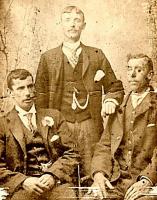
Nat Gould
His life and books
James Adams 1843-1886
| James Adams |
|---|
| Born: 1843 Alstonefield, Staffordshire |
| Died: 1886 New Mills, Derbyshire |
| Father |
| William Adams 1813-1898 |
| Mother |
| Hannah Wood 1812-1902 |
| Siblings |
| Mary Adams |
| Anne Adams 1838-1906 |
| William Adams 1841-1914 |
| Charles Adams 1846-1923 |
| Edwin Adams 1850-1917 |
| John Adams 1853-1932 |
| Ellen Elizabeth Adams 1855-1940 |
| Spouse |
| Mary Ellen Middleton 1848-1926 |
| Children |
| Charles Adams 1869-1942 |
| James Edwin Adams 1873-1937 |
| Martha Elizabeth Adams 1875-1967 |
| Herbert Adams 1878-1946 |
| John William Adams 1880-1909 |
| Edith Mary Adams 1880-1952 |
James Adams was born in 1843 at Alstonefield in Staffordshire, the son of William Adams 1813-1898 and his wife née Hannah Wood. He was baptised on 12 February 1843 at Alstonefield church.
At the village school he proved an excellent scholar.
On 20 April 1869 James Adams married Mary Ellen Middleton at Tideswell parish church in Derbyshire.
They had the following children:
Charles Adams 1869-1942. He was born at Alstonefield in 1869, and married Ellen Bennington Gould 1878-1936 at Ashbourne in 1904. He died on 1 October 1942 at Ashbourne.
James Edwin Adams 1873-1937. He was born in 1873 at New Mills in Derbyshire, and married Maud Howell in 1892 at Warrington. He died in 1937 at Liverpool.
Martha Elizabeth Adams 1875-1967. She was born in 1875 at New Mills, and was married to Joseph Sellers. In the family she was known as Lizzie.
Herbert Adams 1878-1946. He was born in 1878 at New Mills. In the family he was known as Bert.
John William Adams 1880-1909. He was born in 1880 at New Mills, the twin of Edith Mary Adams. In the family he was known as Jack.
Edith Mary Adams 1880-1952. She was born in 1880 at New Mills, the twin of John William Adams. She married Gavin Watson McArthur 1878-1917.
In 1871 James Adams was living in Alstonefield with his wife and infant son Charles Adams 1869-1942. He was then working as an agricultural labourer for Miss Mitchell at Beresford Cottage near Beresford Dale. In 1872 he moved with his family to Stockport Road, Newtown in New Mills, where he worked for the London & North Western Railway as their senior local drayman.
On 1 September 1886 James Adams was killed in an accident in New Mills. He was bringing a load of stone from Kinder Quarry at Hayfield down to Saxby's Calico Printing Works at Furness Vale. He was driving a "lorry" pulled by three horses (3).
Near the Leighton toll bar there was a steep drop down into New Mills, approaching which James Adams intended to apply the brakes. To do this he had to dismount, and was sitting on the cart shafts ready to jump down and apply the brakes. Unfortunately he slipped off the shafts, and dropped to the road behind the horses. The wheels of the heavily laden waggon went over his body. He was not immediately crushed to death, but received terrible injury. Two men were walking up the brow, down which suddenly galloped three horses pulling a cart at great speed (4). Further up the hill they found James Adams lying in the road. He told them that he was killed, and then died (5).
He was buried in the graveyard of St George’s parish church in New Mills, where there was a fine gravestone to his memory by the path along the northern side of the church (6).
James Adams left a young widow and six children, the eldest of whom, Charles Adams, had to become the head of the household and chief breadwinner. As a schoolboy at Newtown school in New Mills, he worked part-time in a local rope factory. The youngest children, twins John William Adams and Edith Mary Adams 1880-1952 went with their mother to live in Fairfield, Buxton in Derbyshire. Of the other children, the sons away to work and Martha Elizabeth Adams went first to an uncle's farm in Alstonefield and later to another uncle in Burton-on-Trent.
(1) The school book is in the possession of his great-granddaughter Sylvia Chadwick.
(2) In the photograph of the Adams brothers are (left) Herbert Adams then aged 21, (standing centre) Charles Adams then aged 30, and (right) James Edwin Adams then aged 26.
(3) Clearly James Adams was a very proficient horseman. Ironically the route that he was taking on the fatal day passed the parish churchyard where he was buried and also close to his home in Stockport Road, Newtown.
(4) Although this is not mentioned in the press reports, presumably the two men succeeded in stopping the horses,terrified by being pushed downhill by the heavy unbraked waggon.
(5) Manchester Evening News 2 September 1886; Sheffield Independent 2, 3 and 4 September 1886; and Manchester Courier and Lancashire General Advertiser 3 and 4 September 1886.
(6) His superb gravestone, with carved ivy for remembrance, was intact in 1970 by the path on the north side of the church, not lost in the tangle of undergrowth that then covered most of the graveyard. Sadly In October 2007 it could not be found. Although space was left on the stone for other names, and presumably in the grave, no-one else was buried there.



